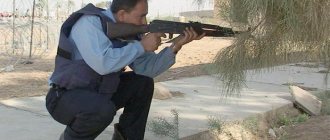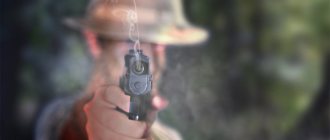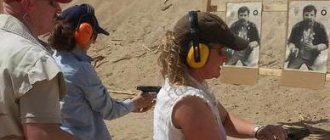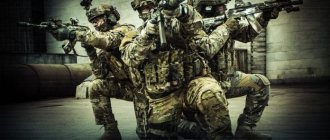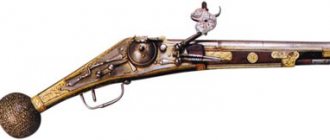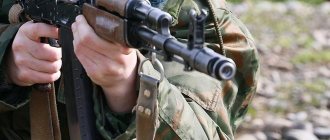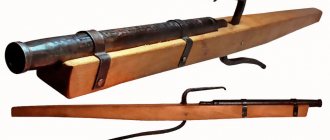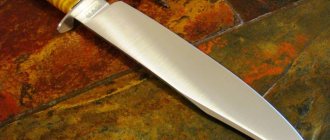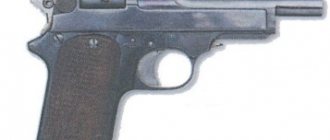Cases when police have the right to use their service weapons against a rioter are regulated by law. This usually occurs when neutralizing a particularly dangerous criminal who directly threatens the life and health of civilians.
A police officer can personally make this decision if, while on duty, he participates in neutralizing the offender, or on the orders of a superior in rank.
In the latter case, all responsibility falls on the one who gave the order. A police officer comes under criminal liability only if there were no grounds for shooting, or the shooting was carried out at persons who cannot be fired at without the most serious reasons.
The law clearly defines the list of situations when a police officer has the right to use weapons. Exceeding official powers is punishable under the relevant article.
If a police officer unlawfully used a weapon while not on duty, then he will be held liable under other articles - as a civilian. If a citizen (a criminal or a passerby who happened to be nearby) was injured during the shooting and believes that the police officer acted illegally, he should go to court.
Do you want to figure it out, but don’t have time to read the article? Lawyers will help
Entrust the task to professionals. Lawyers will complete the order at the cost you specify
141 lawyers on RTIGER.com can help with this issue
Solve the issue >
When the police have the right to use firearms
The use of firearms must strictly correspond to the situation at hand. Police officers must make such decisions based on the grounds for shooting prescribed by law. Often there is not much time to think; it is necessary to act quickly and clearly, which increases the responsibility assigned to the police.
By law, a police officer is required to introduce himself and warn of his intentions, and then give the criminal the opportunity to comply with all requirements. However, the law allows a police officer to go straight to shooting if the criminal must be stopped immediately. The list of situations when authorized persons can use firearms is quite specific:
- The offender attacks a police officer or someone else, and his actions can lead to serious injury or death.
- The criminal is trying to seize weapons, special and military equipment, and vehicles that belong to the police.
- The police release the hostages.
- A police officer caught a criminal performing an action that showed signs of a serious or especially serious crime against life, health or someone else’s property. The criminal is trying to escape, and it is impossible to detain him by other methods.
- Police apprehend a resisting group of armed criminals.
- An armed criminal refuses to comply with the lawful demands of the police and surrender weapons, explosives, toxic and radioactive substances, ammunition, and explosive mechanisms.
- The police repulse armed attacks on public, private, municipal institutions, other premises and structures, citizen organizations, etc.
- When stopping an attempt to escape accused and suspects from places of detention or from under escort, or when attempting to illegally release persons.
- The criminal stole a vehicle, refuses to comply with repeated demands from the police and creates life-threatening situations for citizens on the road.
- We are talking about a dangerous animal that threatens the life and health of police officers and citizens.
- The Ministry of Internal Affairs needs to break into the beast or destroy any other locking mechanism that prevents entry into the premises for one legal reason or another.
- The policeman fires a warning shot in the air. This shot can also serve as an alarm or a request for help. The shot must be fired either upwards or in any other direction that is safe for others.
The use of firearms, especially shooting to kill, indicates the extreme seriousness of the situation, which cannot be resolved by other methods. Cases where police are careful not to shoot, even when the situation requires it, are quite common. This is due to the fact that it is not always possible at first glance to assess the situation as clearly requiring the use of weapons.
The law also contains strict prohibitions on shooting at women, children (if the policeman is aware of the age initially or can be determined by appearance), and people with disabilities.
Exceptions are cases when these persons are armed and attack someone. Also, a police officer has no right to shoot if he is among a large crowd of people, as this can lead to injury and injury to innocent people.
What weapons do employees of the Ministry of Internal Affairs of the Russian Federation have?
Police officers receive weapons according to the area in which they work. If we are talking about a combat unit, then employees can be equipped with a wide range of models. The tool can be used depending on the tasks facing the worker.
For other units there is a universal weapon. Service may involve performing duties with the use of weapons in rare or extreme cases. The pistol must meet all specifications. The equipment of weapons is decided by management. The superiors determine which pistols the private will use. Employees do not buy weapons on their own; they are issued by management.
After receiving permission, workers are given instructions on measures to ensure the safety of weapons and personal safety. A report with permission must be sent to the weapons service.
An official document is an official document that confirms the identity of an employee. The document determines the owner’s right to carry and store service weapons.
What else can the police do?
In addition to the right to use weapons, police officers can also:
- Check documents if a citizen has doubts.
- Call for questioning.
- Visit crime scenes upon presentation of identification.
- Draw up protocols.
- Monitor those who have recently arrived from prison.
- Deliver citizens to police stations, including by force.
- Deliver citizens for medical examination in case of intoxication.
- Carry out an inspection if there is reason to do so.
- Stop vehicles and check documents.
Is it possible to use special equipment instead of weapons?
In addition to weapons, police use many other types of equipment - from a regular rubber stick to water cannons to disperse crowds during riots. Is it allowed to use special equipment instead of firearms?
The law directly provides that a police officer has the right to use less dangerous means instead of more dangerous ones. For example, it is allowed to use:
- physical strength and hand-to-hand combat techniques instead of special equipment;
- special means instead of weapons;
- OOP (weapons of limited destruction) instead of conventional firearms. OOP includes gas, traumatic and light-sound weapons.
The article was written based on materials from the sites: pwpn.ru, www.zakonrf.info, www.grandars.ru, 42.xn--b1aew.xn--p1ai, myscript.ru.
When can it be used
The Law “On Police” stipulates all cases when a law enforcement officer may resort to the use of firearms (the word “use” is excluded). All reasons for application are described in detail in parts 1 and 3 of Article 23 of the Law “On the Police”.
It says that the target for the use of weapons is an individual who commits a dangerous offense against a person, animal or vehicle. It is important to comply with safety measures when handling weapons and have a permit for pneumatic weapons. To find out whether you can use an air pistol for self-defense, see the link.
Other weapon manipulations permitted by the law of the Russian Federation, carried out in the form of demonstration, exposure, bringing to full readiness, infliction of physical blows with a weapon without firing a warning shot, are not legally considered the use of weapons.
Guarantees of compliance with the rule of law for law enforcement officers
Article 16 of the Law “On the Police” stipulates guarantees for the personal safety of a police officer. He has the right to draw his weapon and put it in full combat readiness if, in the opinion of the law enforcement officer, the above-described reasons for use occur.
If a person is holding a weapon in his hands and at the same time tries to approach a police officer, actively reducing the distance between them, or tries to touch his service weapon, the law enforcement officer can use his existing firearm.
The legislation allows the use of weapons in the event of the above-described circumstances against citizens, regardless of the degree of sanity of a person, his age, citizenship, and other nuances - diplomatic and official position, etc. See also useful material about first aid for injuries.
At the same time, it is prohibited to use it against disabled people (obvious signs), females and minors (in this case, the age of the offender is known to the policeman or is clearly visible). But if the above citizens offer resistance, a group or armed attack, or commit other actions that pose a threat to the life and health of other citizens, the use of weapons is permitted.
In this video you will be introduced to Article 23 of the Law of the Russian Federation “On the Police” regarding the use of weapons.
The most serious measure of administrative suppression is the use of firearms. Such actions can result in serious bodily injury, and in some cases, weapons can lead to the death of a person.
In this case, the police officer needs additional guarantee of legal protection of his actions. The law enforcement officer must report all cases of use of weapons within 24 hours in writing (submit a report) to the head of the police department (department) at the place of work.
It is possible to submit a report at the current location of the police officer. If the need arises, the head of the internal affairs body has the right to order an official inspection, during which the legality of the use of weapons will be established.
If, after using a weapon, the attacker was wounded or killed, the prosecutor is immediately notified about this.
We recommend that you read the article about the Makarov MP 371 pistol, which was sensational in its time. See the technique of shooting from a Makarov pistol here.
Defense against attack
The use of firearms by the police is permitted if there is a threat to the life or health of citizens, both civilians and those in the ranks of the Armed Forces. At the same time, it must be stated that it is impossible to protect these persons by other means.
The regiment duty officer is Captain Korolev.”
The regiment duty officer immediately reports the arrival of the listed persons to the regiment commander or the person replacing him.
In the case when the arriving commander (chief) is met by the regiment commander and reports to him, the regiment duty officer only introduces himself.
If generals and admirals not listed in this article, as well as senior officers from a military unit other than their own, arrive at the regiment, the regiment duty officer only introduces himself to them.
For example: “Comrade Major General. The regiment duty officer is Captain Petrov.”
Then he accompanies them to the regiment commander or his deputy.
Other military personnel not from their military unit, after determining their identity and purpose of arrival, if necessary, are admitted to the regiment using one-time passes.
Assistant Regimental Duty Officer
Safety precautions when handling weapons and ammunition
The general rules are as follows:
- the first thing after taking a weapon is to check whether it is loaded; It is forbidden to point the barrel towards people or aim at others;
- you should not allow a potential enemy to aim at you;
- any weapon must be considered loaded before inspection;
- an unloaded weapon should be treated in the same way as a loaded one;
- when cocking the hammer, the barrel should be pointed strictly at the target or upward;
- before starting shooting practice or going on duty, you need to wipe the barrel bore dry, check it for the presence of foreign objects and determine whether the weapon and the equipment supplied with it are in good working order;
- In any situation, it is prohibited to place your finger on the trigger until you need to open fire.
